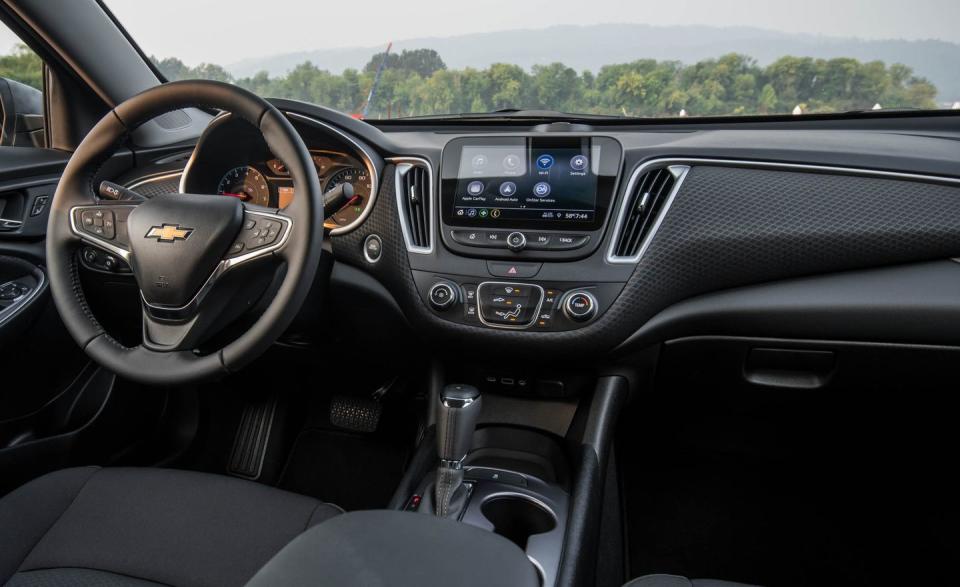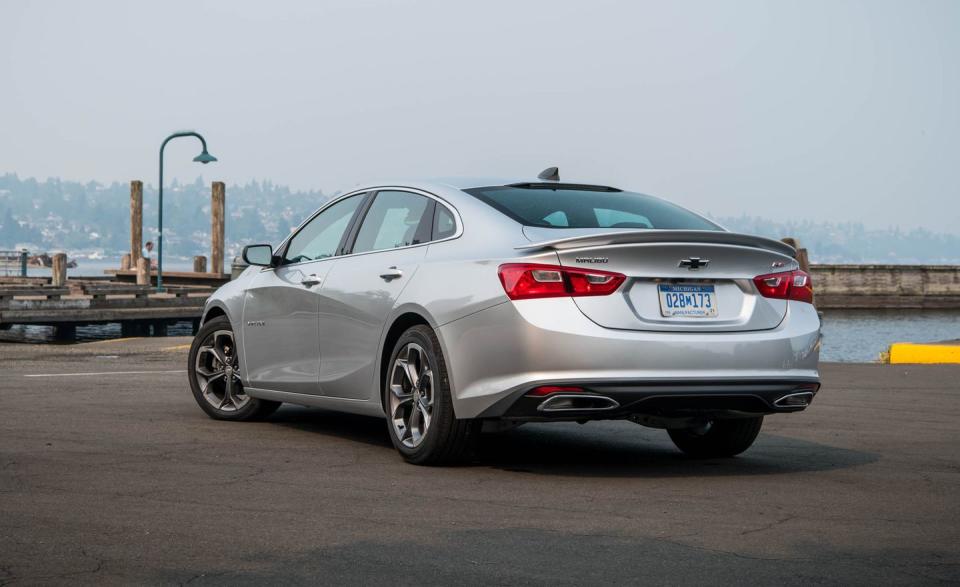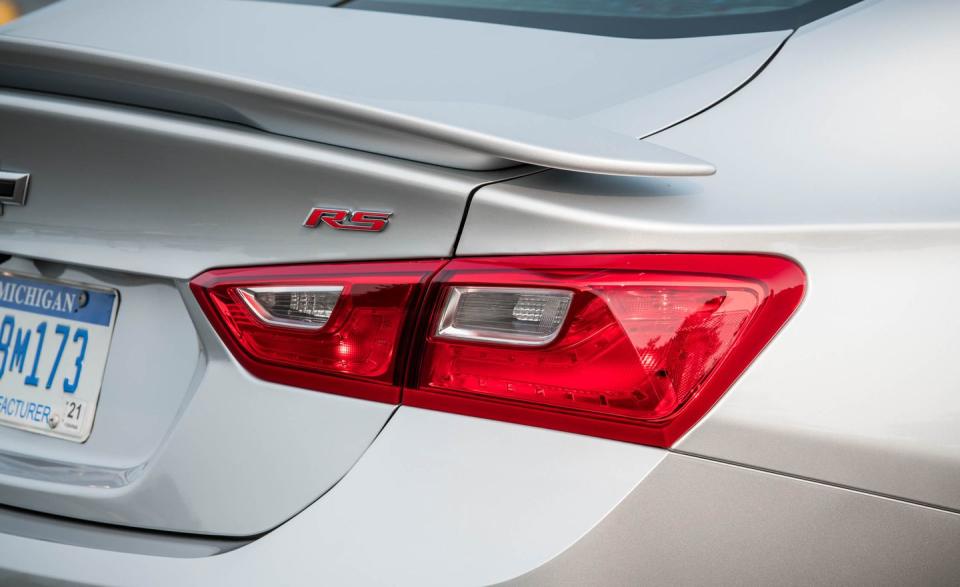2019 Chevrolet Malibu RS Makes a Virtue of Being Unobtrusive

UPDATE 9/12/19: This review has been updated with test results.
Usually the latest underhood hardware comes with great fanfare. When automakers develop new powertrain technologies or components, they tend to brag—and rightly so. This stuff costs a lot of money and takes a long time to develop. It’s not every year that a carmaker introduces an engine or a transmission, which is why the car companies’ marketers are usually left to crow about fascia redesigns or reshuffled trim levels. For 2019, the Chevrolet Malibu delivers all of the above: A bigger, restyled grille; a new RS model; and an all-new continuously variable automatic transmission.
It's the CVT that caught our attention. Known internally as VT40, it replaces the six-speed automatic on last year's base-engine Malibu and is General Motors’ first CVT since 2005. That one, used primarily in Saturn brand vehicles, was problematic and had high failure rates, which led GM to offer an extended warranty. Since then, the only GM vehicle to use a CVT has been the Chevy Spark, and its transmission comes from an outside supplier. Maybe this helps explain why Chevrolet representatives had little to say about the new transmission, even as they handed us the keys to drive a Malibu RS fitted with one.

Every 2019 Malibu with the entry-level 160-hp turbocharged 1.5-liter inline-four will get the VT40, which is being produced in GM’s facility in Ramos Arizpe, Mexico. (The more powerful turbocharged 2.0-liter Malibu uses a nine-speed automatic, while the hybrid uses a power-split device to combine its electrical and piston-engine power sources that we also categorize as a CVT, but that's a completely different animal.) The Malibu is the new CVT's first retail application, although it is also paired with a turbocharged 1.4-liter four in the Chevrolet Cruze for fleet customers only. The VT40 has a chain-drive design for front-wheel-drive vehicles; GM declined to specify its maximum torque capacity, but we can conclude from its initial appearances that it’s not going to find its way into anything too heavy or powerful. It has a relatively wide ratio spread of 7.0:1—for comparison, the six-speed’s ratio is 6.1:1, and the nine-speed automatic in top-spec Malibus has a ratio of 7.6:1.
This wider ratio spread helps improve the Malibu's efficiency at lower speeds. EPA-estimated city and combined fuel economy figures improve by 2 mpg—from 27 mpg city to 29, and from 30 mpg combined to 32—while the 'Bu's highway efficiency remains a solid 36 mpg. We averaged 25 mpg with our particular test car, thanks to our rather heavy feet and congested commutes, yet saw only 34 mpg on our 75-mph highway fuel-economy evaluation. However, the CVT helps the base 2019 Malibu accelerate more quickly. The trip from zero to 60 mph now takes a so-so 7.8 seconds, 0.4-second shorter than before, and 0.4-to-0.5 seconds have been chopped from the sedan's 30-to-50-mph and 50-to-70-mph passing times, too.

Out in the real world, most drivers will find it difficult to tell a VT40-equipped Malibu from one with a conventional automatic. A simulated shift program with seven set ratios does a good impression of a step-gear transmission, which is about all you can ask of a CVT from behind the wheel. During full-throttle acceleration, the transmission changes the ratio without fail when the engine speed hits 5500 rpm, and the revs drop in a familiar and reassuring way before a higher ratio is selected. Each of the seven steps can also be selected manually with the switch on top of the gearshift lever, and the transmission holds that ratio until the driver chooses another one, just as it should. There are some conventional automatics that could take behavior lessons from GM’s CVT.
The VT40 does on occasion cause the Malibu’s engine to drone, especially during lighter acceleration. It is still a CVT, after all. More frustrating is that the car’s throttle response is as soft as a throw pillow, and the accelerator has an initial dead spot that discourages spirited driving. This calibration may save more fuel for some Malibu drivers than the transmission does. If you want a Malibu that’s more fun to drive—think a zero-to-60-mph time closer to six seconds—you should be buying the 250-hp turbocharged 2.0-liter model that comes with a nine-speed automatic anyway.

Chevrolet has the 2019 RS priced at $25,095 to start, undercutting by $2015 the 2019 price of its most obvious bogey, the Honda Accord Sport, which also packs a turbo 1.5-liter four and a CVT. Taking on the Accord Sport, which may well be the best bang for the buck on four wheels, is a fool’s errand, so it’s not surprising that Chevy didn’t try too hard with the RS. Its dark chrome trim, 18-inch wheels, and black bow tie look menacing, but that’s all for show, with no mechanical upgrades over the stock Malibu. The Accord Sport, on the other hand, gets 19-inch wheels, a sport suspension tuning with upgraded brakes, and a manual-transmission option. Accords have 32 horsepower more than the 160-hp Malibu, too, with more stylish and upscale cabins.
So, while that shiny new RS badge may hint at something more, the 2019 Malibu is still a soft, smooth-riding family car, just like last year. The new CVT fits its character perfectly.
You Might Also Like

 Yahoo Autos
Yahoo Autos 